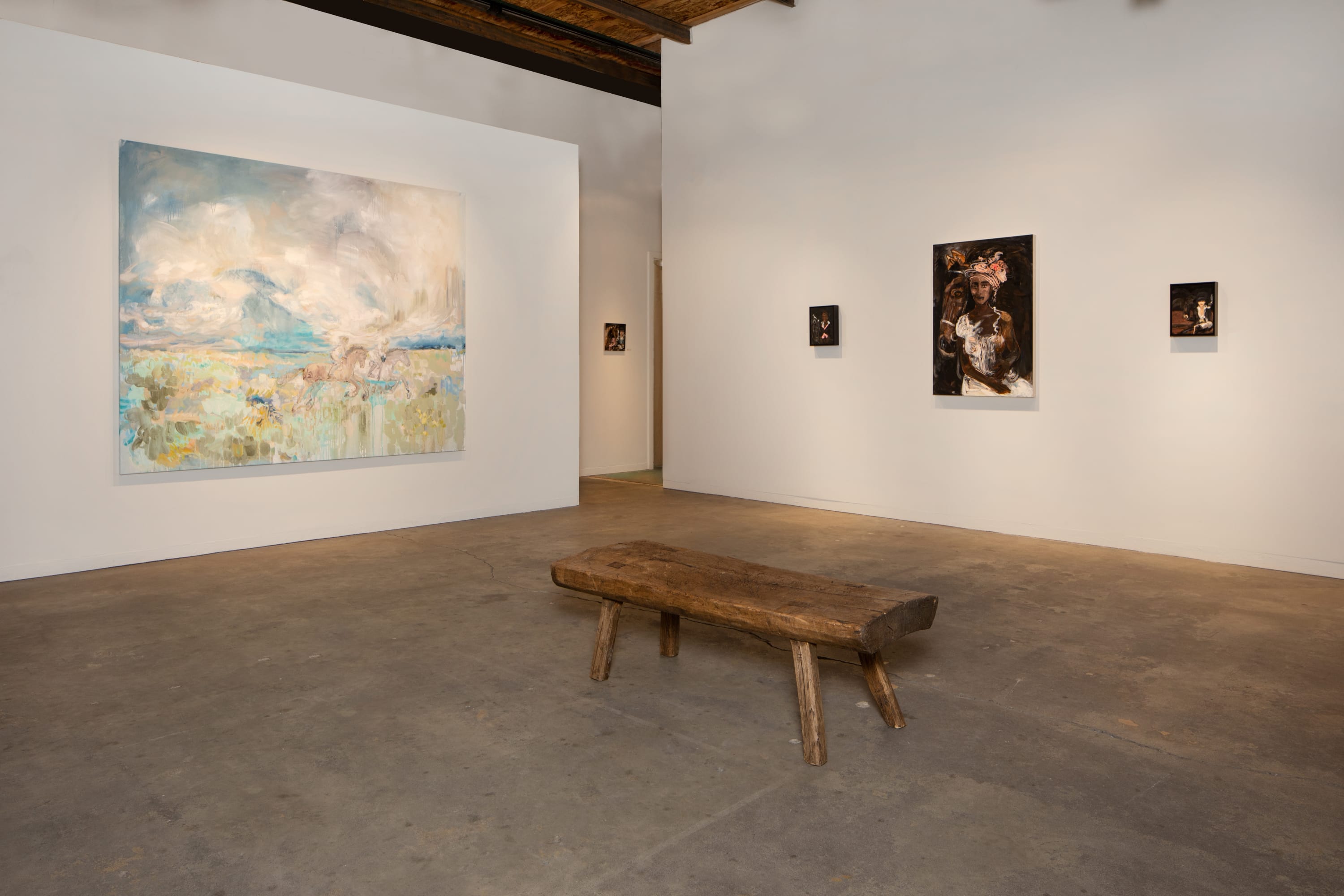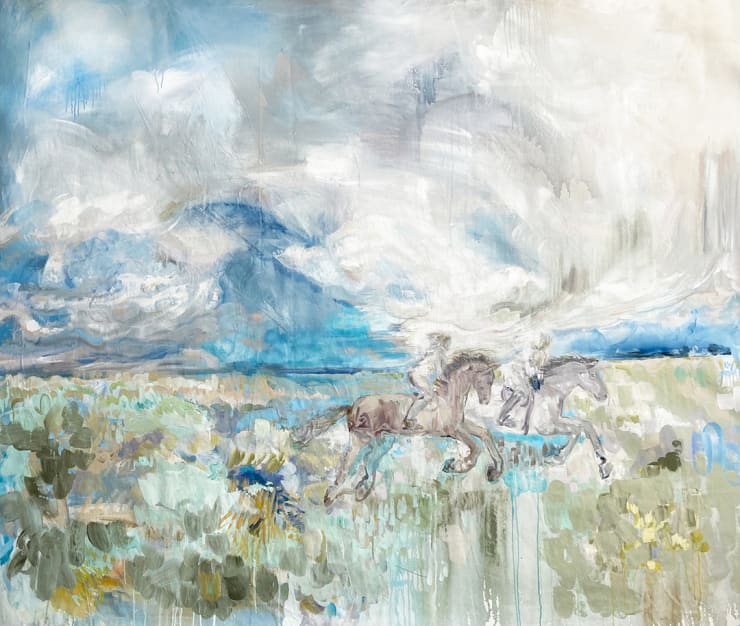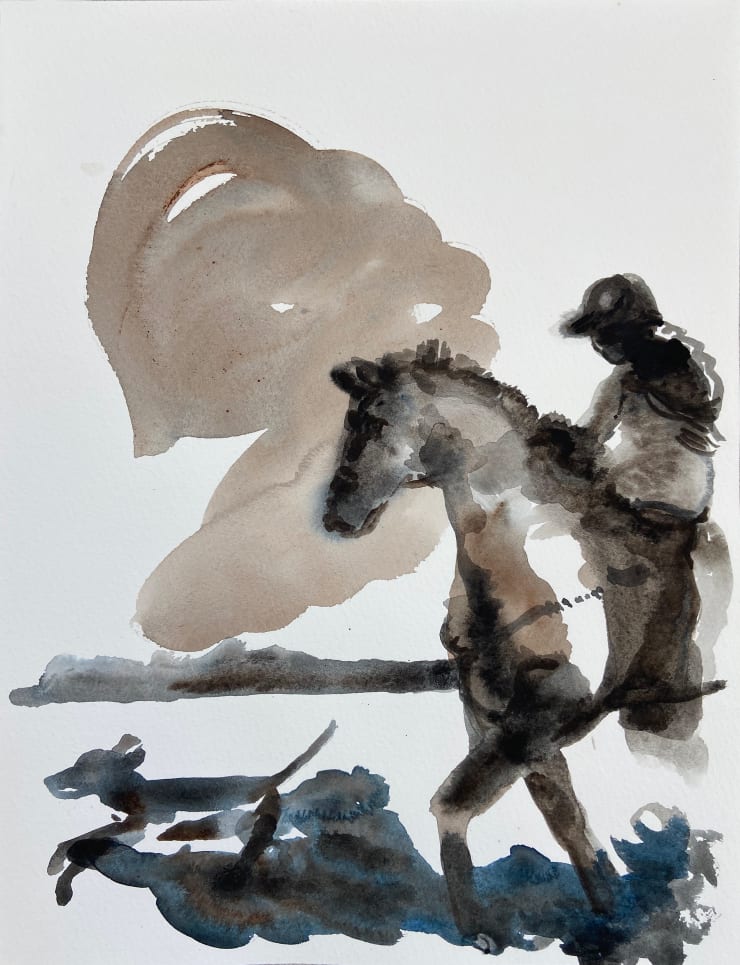-
FADING LANDSCAPE
BY SUZY SPENCE -
Fading Landscape, an exhibition of paintings by American artist Suzy Spence, presents a range of work completed over the last two years, from near-monumental-scale landscapes on canvas to intimate works on paper and painterly portraiture. Additionally, the exhibition introduces the artist’s hand-printed, equestrian neo-toile wallpaper, produced this year in collaboration with historic Red Disk Studios in Buffalo, New York.
Presented in two rooms in the gallery’s main space, the exhibition probes the history of the domestic space, a theme running throughout Suzy Spence’s work, with wild, galloping landscapes offering a window looking out-of- doors. Billowing clouds puff out over a gestural, almost saccharine blue-and-ochre landscape in Cloud Gallop, as two riders nearly indistinguishable from the field of golden wildflowers race across the expanse. Back indoors, with a nod to equestrian portraiture, another Spence motif, Royal Ascot (flowers) is emblazoned with a massive floral headpiece and gauzy gown that could feel equally at home in a baroque masterpiece (Charles le Brun’s Louis XIV, e.g.) or on the runway of an Alexander McQueen show. Spence’s brushstrokes have the quick confidence fitting for such a juxtaposition; New York school, but make it history.
-
Spence has been investigating the tropes and tradition of the English hunting scene since her residency at Skowhegan in 1996. The early nineteen-nineties marked a dark period for painting in American art; painters were largely outré, the taste was for social commentary and conceptual art. Originally, she says, “I was treating it as a failed painting, as a conversation about class and taste. But the paintings themselves were kind of beautiful.” Today, she’s abandoned that sense of irony. “I’m very invested in my subject matter," she says, “I'm owning it.”
In owning, even honoring, her subject matter, certain things have shifted in her artistic process. “I’ve given myself the permission to work much faster, and to finish things in just a couple of sittings,” she says. “Even a large piece, and that was something I’ve always felt obligated to do—to spend much time with work. And I don’t feel that way anymore. I often feel my work is much better if I just let go sooner. That’s been a big shift for me.”
-
“The work has become more lyrical. If I had used that word ten or twenty years ago to describe my work, I would have said, ‘What are you doing, Suzy? That is so cheesy.’ But it’s really true. The work feels more poetic and more lyrical. It’s very liberating, because I started with the traditional English hunt scene as the basis of the work, and I’ve been able to let go of that. I’ve held on in some places to the little scraps, so that it’s pinned down in places to those tropes from the traditional English hunting scenes, but I’m really messing with the boundaries that I set up.”
-
-
Those boundaries include the way we think about art and artist’s projects. Spence’s wallpaper, handmade silkscreens based on the artist’s paintings, came about following a brilliant exhibition at the Whitney Museum in 2010, Charles Burchfield, curated by Robert Gober. Burchfield had a stint as a wallpaper designer in Buffalo, N.Y., and Spence loved the way the paper looked with his work. The museum walls were transformed into a living interior. She worked with the modern-day version of Burchfield’s company, which produces a bespoke, handmade product down to the paint, which is mixed locally in Buffalo.
-

Join our mailing list
* denotes required fields
We will process the personal data you have supplied in accordance with our privacy policy (available on request). You can unsubscribe or change your preferences at any time by clicking the link in our emails.





























